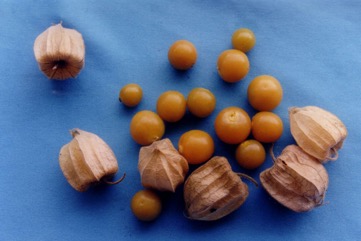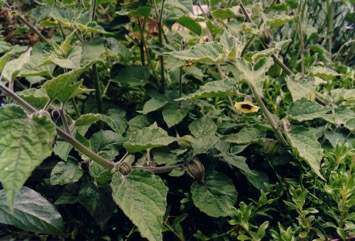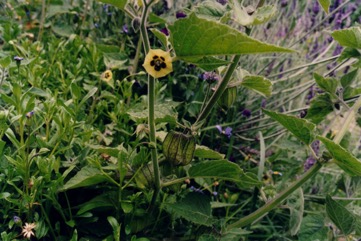Cape gooseberry

A temperate plant. It grows in the tropical highlands. It suits warm climates. It does best in warm sunny conditions. It needs well drained soil. It is best free from severe frosts and strong winds. In Nepal it grows between 900-2200 m altitude. Plants are not killed by a slight frost. In Indonesia plants are found between 700-2300 m altitude but fruit best above 1500 m. In the Andes it grows between 2,000-2,800 m above sea level. It can grow in arid places. It suits hardiness zones 8-10. Tasmania Herbarium. In Yunnan.
Also known as:
Aguaymanto, Awxetecha, Aztec berry, Bari-papaton, Bolsa de amor, Bosiya, Buddabasara, Buhkol, Butuanyil, Buufu, Capuli, Cecendet badak, Ceplukan, Cereza del Peru, Chinese lantern, Chirboti, Chirput, Deng long guo, Donam as, Entutu, Etagoli loapolon, Giant ground cherry, Gobbayas, Golden berry, Goldenberry, Gongor, Gooseberry-tomato, Guchavo, Gudde hannu, Gumbais, Gusboeri, Habit bokbok, Harankash, Hawteta, Hozuki, Hpaung-hpaung-ti, Inca berry, Jam, Jamo, Jamu, Jangali mewa, Kala-myetsi-pinzauk-gyi, Kamaigomara, Karimpotti, Khaokhashi, Korelashii, Lobo-lobahan, Loliy, Luketa karma, Maree'ra, Mchupwa, Mewar rashberry, Moti popti, Motojobobo embolsado, Msupu, Mtumbua, Nsongwa, Ntongo, Ntuntunu, Ntuutu, Pa'ina, Perijsko volčje jabolko, Peruvian ground-cherry, Peruvian-cherry, Phopti, Poha, Pok pok, Ras bhari, Rasbharry, Shawa, Songwa, Tankari, Te baraki, Tepari, Thamungwal, Thebong kang, Tholtakkali, Tipari, Tipariya, Tongogwai, Tunaye, Uchuba, Uchuva, Uvilla, Vejigon
Synonyms
- Physalis chenopodifolia Lam.
- Physalis pruinosa
- Physalis edulis Sims
- Physalis pubescens L.
Edible Portion
- Fruit, Leaves, Vegetable
Where does Cape gooseberry grow?
Found in: Africa, Andes, Australia, Bangladesh, Bolivia, Brazil, Britain, Cameroon, Central Africa, Chile, China, Colombia, Cook Islands, Congo DR, Dominican Republic, East Africa, Ecuador, Egypt, Eswatini, Ethiopia, Fiji, France, Ghana, Haiti, Hawaii, Himalayas, India, Indochina, Indonesia, Italy, Kenya, Kiribati, Lesotho, Madagascar, Malawi, Malaysia, Marquesas, Mediterranean, Mexico, Mozambique, Myanmar, Namibia, Nepal, New Zealand, Nigeria, Norfolk Island, North America, Northeastern India, Pacific, Pakistan, Papua New Guinea, PNG, Peru, Philippines, Sao Tome and Principe, SE Asia, Sierra Leone, Slovenia, South Africa, Southern Africa, South America, South Sudan, Spain, St Helena, Swaziland, Tanzania, Tasmania, Thailand, Tonga, Uganda, United States, Venezuela, West Africa, West Indies, Zambia, Zimbabwe
Notes: There are about 75-100 Physalis species.
Status: It is a commercially cultivated vegetable. The fruit are popular especially with children.
Growing Cape gooseberry
Cultivation: Plants are grown from seed. They are broadcast over the soil. Seeds should be 1.5 cm deep in loose soil. Seed germinate irregularly. Plants should be spaced 45 cm apart. In the tropics plants keep growing from year to year but in the subtropics they regrow from seed each year. Plants can be grown from softwood cuttings from the upper parts of the shoots. Seedlings can be transplanted.
Edible Uses: The ripe fruit are eaten fresh or cooked. They are used for jam. They can be dried, preserved, stewed, pureed, or used in pies, cakes, jellies and sauces. Roasted seeds are pickled. The leaves have been used instead of hops in beer. The leaves are also boiled and used as a potherb.
Production: Plants produce in 1 year. A single plant can produce 300 fruit. Fruit can be stored for several months in dry conditions.
Nutrition Info
per 100g edible portion| Edible Part | Energy (kcal) | Protein (g) | Iron (mg) | Vitamin A (ug) | Vitamin c (mg) | Zinc (mg) | % Water |
|---|---|---|---|---|---|---|---|
| Fruit mature | 48 | 2 | 1.5 | 1200 | 30 | - | 84.2 |
Cape gooseberry Photos



References
Addis, G., et al, 2005, Ethnobotanical Study of Edible Wild Plants in Some Selected Districts of Ethiopia. Human Ecology, Vol. 33, No. 1, pp. 83-118
Addis, G., Asfaw, Z & Woldu, Z., 2013, Ethnobotany of Wild and Semi-wild Edible Plants of Konso Ethnic Community, South Ethiopia. Ethnobotany Research and Applications. 11:121-141
Agea, J. G., et al 2011, Wild and Semi-wild Food Plants of Bunyoro-Kitara Kingdom of Uganda: etc. Environmental Research Journal 5(2) 74-86
Ajesh, T. P., et al, 2012, Ethnobotanical Documentation of Wild Edible Fruits used by Muthuvan Tribes of Idukki, Kerala-India. International Journal of Pharma and Bio Sciences 3(3): 479-487
Ambasta, S.P. (Ed.), 2000, The Useful Plants of India. CSIR India. p 452
Arora, R. K., 2014, Diversity in Underutilized Plant Species - An Asia-Pacific Perspective. Bioversity International. p 81
Asfaw, Z. and Tadesse, M., 2001, Prospects for Sustainable Use and Development of Wild Food Plants in Ethiopia. Economic Botany, Vol. 55, No. 1, pp. 47-62
Ashagre, M., et al, 2016, Ethnobotanical study of wild edible plants in Burji District, Segan Area Zone of Southern Nations, Nationalities and Peoples Region (SNNPR), Ethiopia. Journal of Ethnobiology and Ethnomedicine (2016) 12:32
Awas, T., 1997, A Study on the Ecology and Ethnobotany of Non-cultivated Food Plants and Wild Relatives of Cultivated crops in Gambella Region, Southwestern Ethiopia. Addis Ababa University. p 68
Balemie, K., & Kebebew, F., 2006, Ethnobotanical study of wild edible plants in Derashe and Kucha Districts, South Ethiopia. Journal of Ethnobiology and Ethnomedicine.
Barcelo, R., 2015, Phytochemical Screening and Antioxidant Activity of Edible Wild Fruits in Benguet, Cordillera Administrative Region, Philippines. Electronic Journal of Biology, 2015, Vol.11(3): 80-89
Barrau, J., 1976, Subsistence Agriculture in Polynesia and Micronesia. Bernice P. Bishop Museu, Bulletin 223 Honolulu Hawaii. Kraus reprint. p 59
Berihun, T. & Molla, E., 2017, Study on the Diversity and Use of Wild Edible Plants in Bullen District Northwest Ethiopia. Hindawi Journal of Botany. Article ID 8383468
Blamey, M and Grey-Wilson, C., 2005, Wild flowers of the Mediterranean. A & C Black London. p 404
Bortolotto, I. M., et al, 2018, Lista preliminar das plantas alimenticias nativas de Mato Grosso do Sul, Brasil. Iheringia, Serie Botanica, Porto Alegre, 73 (supl.):101-116
Bourke, R. M., Altitudinal limits of 230 economic crop species in Papua New Guinea. Terra australis 32.
Burkill, H. M., 1985, The useful plants of west tropical Africa, Vol. 5. Kew.
Burnie, G.(Ed.), 2003, Annuals and Bulbs. The Gardener's Handbooks. Fog City Press. p 210
Bvenura, C. and Afolayan, A. J., 2017, Tackling food and nutrition insecurity using leafy wild vegetables: The nutritional compositions of some selected species.
Castillo, R. O., 1995, Plant Genetic Resources in the Andes: Impact, Conservation, and Management. Crop Science 35:355-360
Cheifetz, A., (ed), 1999, 500 popular vegetables, herbs, fruits and nuts for Australian Gardeners. Random House p 218
Chowdery, T., et al, 2014, Wild edible plants of Uttar Dinajpur District, West Bengal. Life Science Leaflets. 47:pp 20-36 http://lifesciencesleaflets.ning.com
Chua-Barcelo, R. T., 2014, Ethnobotanical survey of edible wild fruits in Benguet, Cordillera administrative region, the Philippines. Asian Pac. J. Trop. Biomed. 4(Suppl. 1):S525-S538
Cooper, W. and Cooper, W., 2004, Fruits of the Australian Tropical Rainforest. Nokomis Editions, Victoria, Australia. p 518
Cribb, A.B. & J.W., 1976, Wild Food in Australia, Fontana. p 73
Cundall, P., (ed.), 2004, Gardening Australia: flora: the gardener's bible. ABC Books. p 1037
Cunningham, A. B., 1996, People, park and plant use. Division of Ecological Sciences, UNESCO. p 56
Das, S. and De, B., 2013, Evaluation of Angiotension I-Converting Enzyme (ACE) inhibitory potential of some underutilized indigenous fruits of West Bengal using an in vitro model. Fruits, Vol. 68:499-506
Ethnobotany of Karbis. Chapter 4 in p 99, 105
Facciola, S., 1998, Cornucopia 2: a Source Book of Edible Plants. Kampong Publications, p 235
FAO, 1988, Traditional Food Plants, FAO Food and Nutrition Paper 42. FAO Rome p 408
Flora of Australia Volume 49, Oceanic Islands 1, Australian Government Publishing Service, Canberra. (1994) p 302
Flora of Pakistan. www.eFloras.org
Fowler, D. G., 2007, Zambian Plants: Their Vernacular Names and Uses. Kew. p 61
Fox, F. W. & Young, M. E. N., 1982, Food from the Veld. Delta Books. p 344
Franklin, J., Keppel, G., & Whistler, W., 2008, The vegetation and flora of Lakeba, Nayau and Aiwa Islands, Central Lau Group, Fiji. Micronesica 40(1/2): 169–225, 2008
Godfrey, J. et al, 2013, Harvesting, preparationand preservation of commonly consumed wild and semi-wild food plants in Bunyoro-Kitara Kingdom, Uganda. Int. J. Med. Arom. Plants. Vol.3 No.2 pp 262-282
Goode, P., 1989, Edible Plants of Uganda. FAO p 27
Goode, P., 1989, Edible Plants of Uganda. FAO p 40
Gouldstone, S., 1983, Growing your own Food-bearing Plants in Australia. Macmillan p 83
Grubben, G. J. H. and Denton, O. A. (eds), 2004, Plant Resources of Tropical Africa 2. Vegetables. PROTA, Wageningen, Netherlands. p 564
Harkonen, M. & Vainio-Mattila, K., 1998, Some examples of Natural Products in the Eastern Arc Mountains. Journal of East African Natural History 87:265-278
Harris, S., Buchanan, A., Connolly, A., 2001, One Hundred Islands: The Flora of the Outer Furneaux. Tas Govt. p 202
Hedrick, U.P., 1919, (Ed.), Sturtevant's edible plants of the world. p 492
Hermandez Bermejo, J.E., and Leon, J. (Eds.), 1994, Neglected Crops. 1492 from a different perspective. FAO Plant Production and Protection Series No 26. FAO, Rome. p 117 (As Physalis chenopodifolia)
Hibbert, M., 2002, The Aussie Plant Finder 2002, Florilegium. p 232
Hiddins, L., 1999, Explore Wild Australia with the Bush Tucker Man. Penguin Books/ABC Books. p 133
Hermandez Bermejo, J.E., and Leon, J. (Eds.), 1994, Neglected Crops. 1492 from a different perspective. FAO Plant Production and Protection Series No 26. FAO, Rome. p17
http://www.botanic-gardens-ljubljana.com/en/plants
Hussey, B.M.J., Keighery, G.J., Cousens, R.D., Dodd, J., Lloyd, S.G., 1997, Western Weeds. A guide to the weeds of Western Australia. Plant Protection Society of Western Australia. p 220
Hu, Shiu-ying, 2005, Food Plants of China. The Chinese University Press. p 665
INFOODS:FAO/INFOODS Databases
Jardin, C., 1970, List of Foods Used In Africa, FAO Nutrition Information Document Series No 2.p 155
John, L., & Stevenson, V., 1979, The Complete Book of Fruit. Angus & Robertson p 94
Kar, A., & Borthakur, S. K., 2008, Wild vegetables of Karbi - Anglong district, Assam, Natural Product Radiance, Vol. 7(5), pp 448-460
Katende, A.B., Birnie, A & Tengnas B., 1995, Useful Trees and Shrubs for Uganda. Identification, Propagation and Management for Agricultural and Pastoral Communities. Technical handbook No 10. Regional Soil Conservation Unit, Nairobi, Kenya. p 490
Kays, S. J., and Dias, J. C. S., 1995, Common Names of Commercially Cultivated Vegetables of the World in 15 languages. Economic Botany, Vol. 49, No. 2, pp. 115-152
Khan, D. & Shaukat, S.S., 2006, The Fruits of Pakistan: Diversity, Distribution, Trends of Production and Use. Int. J. Biol. Biotech., 3(3):463-499
Kiple, K.F. & Ornelas, K.C., (eds), 2000, The Cambridge World History of Food. CUP p 1744
Latham, P & Mbuta, A., 2017, Useful Plants of Central Province, Democratic Republic of Congo. Volume 2. Salvation Army p 101
Lazarides, M. & Hince, B., 1993, Handbook of Economic Plants of Australia, CSIRO. p 189
Long, C., 2005, Swaziland's Flora - siSwati names and Uses http://www.sntc.org.sz/flora/
Low, T., 1991, Wild Herbs of Australia and New Zealand. Angus & Robertson. p 100 (Drawing)
Low, T., 1991, Wild Food Plants of Australia. Australian Nature FieldGuide, Angus & Robertson. p 112
Low, T., 1992, Bush Tucker. Australia’s Wild Food Harvest. Angus & Robertson. p 76
Lyle, S., 2006, Discovering fruit and nuts. Land Links. p 323
Macmillan, H.F. (Revised Barlow, H.S., et al) 1991, Tropical Planting and Gardening. Sixth edition. Malayan Nature Society. Kuala Lumpur. p 316
Malaisse, F., 1997, Se nourrir en floret claire africaine. Approche ecologique et nutritionnelle. CTA., p 67
Manandhar, N.P., 2002, Plants and People of Nepal. Timber Press. Portland, Oregon. p 361
Martin, F.W. & Ruberte, R.M., 1979, Edible Leaves of the Tropics. Antillian College Press, Mayaguez, Puerto Rico. p 76, 220
Maundu, P. et al, 1999, Traditional Food Plants of Kenya. National Museum of Kenya. 288p
Morton, Julia F., 1987, Fruits of Warm Climates. Creative Resources Systems, Inc. . p. 430
Msuya, T. S., et al, 2010, Availability, Preference and Consumption of Indigenous Foods in the Eastern Arc Mountains, Tanzania, Ecology of Food and Nutrition, 49:3, 208-227
Murtem, G. & Chaudhrey, P., 2016, An ethnobotanical note on wild edible plants of Upper Eastern Himalaya, India. Brazilian Journal of Biological Sciences, 2016, v. 3, no. 5, p. 63-81
Musinguzi, E., et al, 2006, Utilization of Indigenous Food Plants in Uganda: A Case Study of South-Western Uganda. AJFAND Vol. 6(2):
Nayaham, M. C., et al, 1993, Less Known Edible Fruit - Yielding plants of Nilgiris. Ancient Science of Lif. Vol. X11 Nos. 3 & 4, pp 363-376
Ojelel, S. & Kakudidi, E. K., 2015, Wild edible plant species utilized by a subsistence farming community in the Obalanga sub-county, Amuria district, Uganda. Journal of Ethnobiology and Ethnomedicine. 11:7
Ojelel, S., et al, 2019, Wild edible plants used by communities in and around selected forest reserves of Teso-Karamoja region, Uganda. Journal of Ethnobiology and Ethnomedicine (2019) 15:3
Oryema, C., et al, 2013, Edible wild fruit species of Gulu District, Uganda. International Journal of Biology and Biological Sciences Vol 2(4) pp 068-082
Paczkowska, G . & Chapman, A.R., 2000, The Western Australian Flora. A Descriptive Calatogue. Western Australian Herbarium. p 537
Pasha, M. K. & Uddin, S. B., 2019, Minor Edible Fruits of Bangladesh. Bangladesh J. Plant Taxon. 26(2): 299–313
Pfoze, N. L., et al, 2012, Survey and assessment of floral diversity on wild edible plants from Senapati district of Manipur, Northeast India. Journal of Biodiversity and Environmental Sciences. 1(6):50-52
Plants for a Future database, The Field, Penpol, Lostwithiel, Cornwall, PL22 0NG, UK. http://www.scs.leeds.ac.uk/pfaf/
Plants of Haiti Smithsonian Institute http://botany.si.edu/antilles/West Indies
PROSEA (Plant Resources of South East Asia) handbook, Volume 2, 1991, Edible fruits and nut. p 254
Purseglove, J.W., 1968, Tropical Crops Dicotyledons, Longmans. p 523
Rashid, H. E., 1977, Geography of Bangladesh. Westview. p 349
Royal Botanic Gardens, Kew (1999). Survey of Economic Plants for Arid and Semi-Arid Lands (SEPASAL) database. Published on the Internet; http://www.rbgkew.org.uk/ceb/sepasal/internet [Accessed 11th June 2011]
Ruiters-Welcome, A. K., 2019, Food plants of southern Africa. Ph.D. thesis. Univ. of Johannesburg p 103
Samuels, J., 2015, Biodiversity of Food Species of the Solonaceae Family: A Preliminary Taxonomic Inventory of Subfamily Solanoideae. Resources 2015, 4. 277-322
Sasi, R. & Rajendran, A., 2012, Diversity of Wild Fruits in Nilgiri Hills of the Southern Western Ghats - Ethnobotanical Aspects. IJABPT, 3(1) p 82-87
Segura, S., et al, 2018, The edible fruit species in Mexico. Genet Resour Crop Evol (2018) 65:1767–1793
Sharma, B.B., 2005, Growing fruits and vegetables. Publications Division. Ministry of Information and broadcasting. India. p 30
Sillitoe, P. 1995, An Ethnobotanical Account of the Plant Resources of the Wola Region, Southern Highlands Province, Papua New Guinea. J. Ethnobiol. 15(2): 201-235
Sina, B. & Degu, H. D., 2015, Knowledge and use of Wild Edible Plants in the Hula District of the Sidama Zone. International Journal of Bio-resource and Stress Management 6(3):352-365
Skinner, G. & Brown, C., 1981, Simply Living. A gatherer's guide to New Zealand's fields, forests and shores. Reed. p 36
Solomon, C., 2001, Encyclopedia of Asian Food. New Holland. p 175
Sp. pl. ed. 2, 2:1670. 1763
Stanley, T. D. & Ross, E. M., 1986, Flora of south-eastern Queensland Volume 2. Queensland Government p 428
Swaziland's Flora Database http://www.sntc.org.sz/flora
Tasmanian Herbarium Vascular Plants list p 56
Teron, R. & Borthakur, S. K., 2016, Edible Medicines: An Exploration of Medicinal Plants in Dietary Practices of Karbi Tribal Population of Assam, Northeast India. In Mondal, N. & Sen, J.(Ed.) Nutrition and Health among tribal populations of India. p 155
Terra, G.J.A., 1973, Tropical Vegetables. Communication 54e Royal Tropical Institute, Amsterdam, p 67
Tindall, H.D., 1983, Vegetables in the Tropics, Macmillan p 359
Thaman, R. R., 1987, Plants of Kiribati: A listing and analysis of vernacular names. Atoll Research Bulletin No. 296
TodaFruta.com.br
USDA, ARS, National Genetic Resources Program. Germplasm Resources Information Network - (GRIN). [Online Database] National Germplasm Resources Laboratory, Beltsville, Maryland. Available: www.ars-grin.gov/cgi-bin/npgs/html/econ.pl (10 April 2000)
Van den Eynden, V., et al, 2003, Wild Foods from South Ecuador. Economic Botany 57(4): 576-603
van Wyk, B., 2005, Food Plants of the World. An illustrated guide. Timber press. p 294
van Wyk, Be., & Gericke, N., 2007, People's plants. A Guide to Useful Plants of Southern Africa. Briza. p 54
Vivien, J., & Faure, J.J., 1996, Fruitiers Sauvages d'Afrique. Especes du Cameroun. CTA p 334
Wehmeyer, A. S, 1986, Edible Wild Plants of Southern Africa. Data on the Nutrient Contents of over 300 species
Williamson, J., 2005, Useful Plants of Malawi. 3rd. Edition. Mdadzi Book Trust. p 200
World Checklist of Useful Plant Species 2020. Royal Botanic Gardens, Kew
Yamada, T., 1999, A report of the Ethnobotany of the Nyindu in the Eastern part of the former Zaire. African Study Monographs 20(1):1-72
Yuncker, T.G., 1959, Plants of Tonga, Bernice P. Bishop Museum, Hawaii, Bulletin 220. p 236